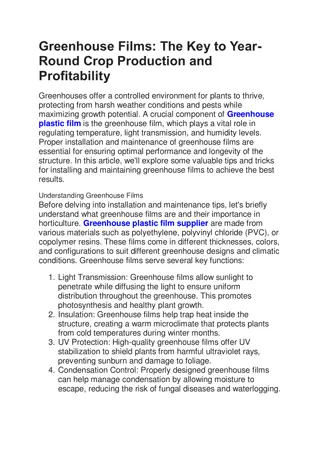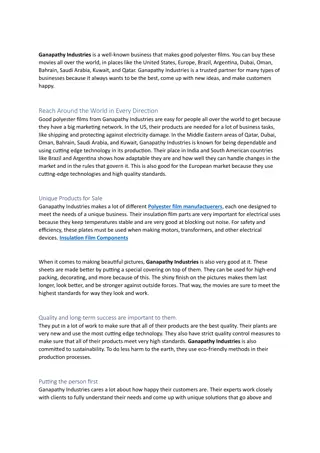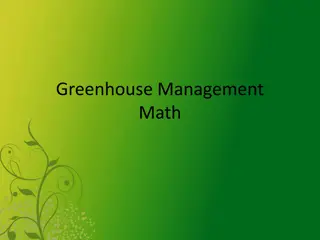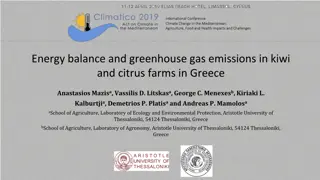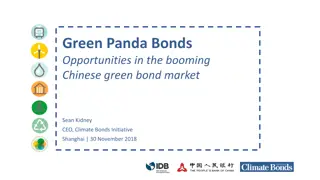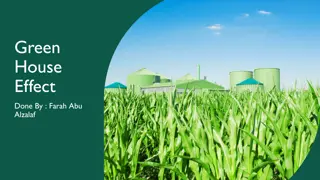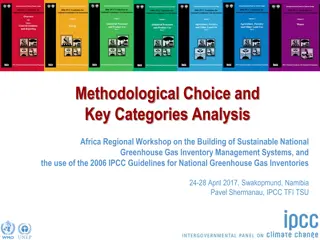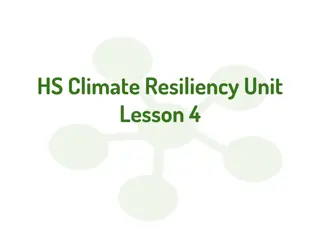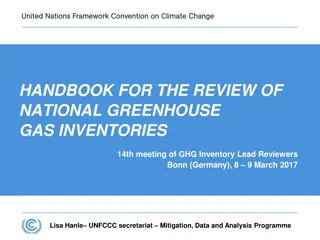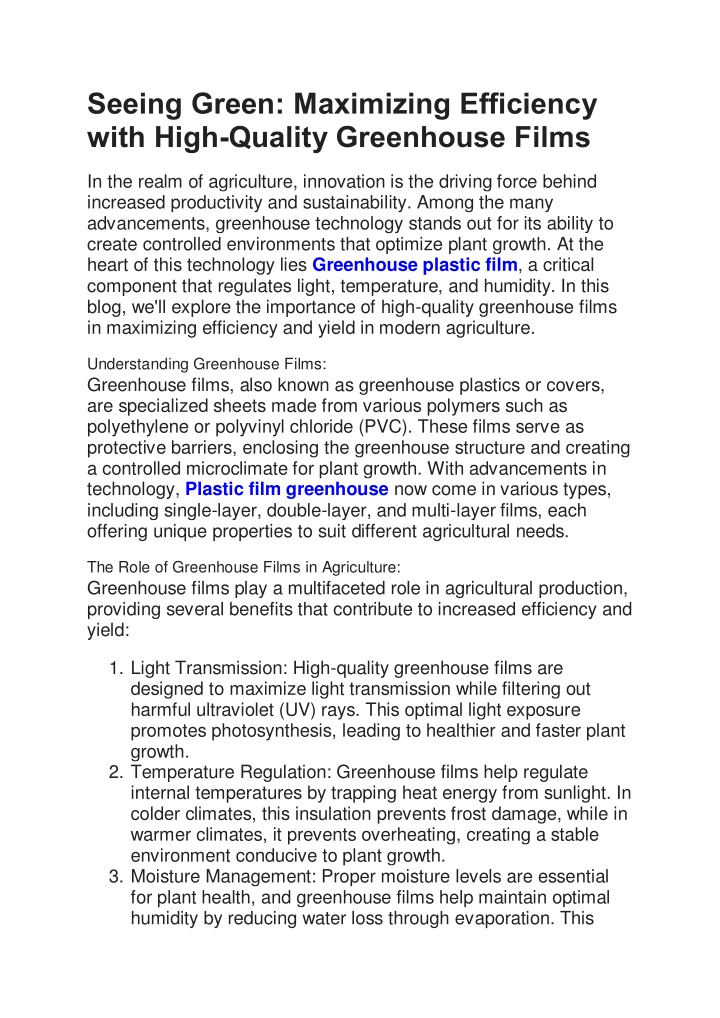
Seeing Green: Maximizing Efficiency with High-Quality Greenhouse Films
In the realm of agriculture, innovation is the driving force behind increased productivity and sustainability. Among the many advancements, greenhouse technology stands out for its ability to create controlled environments that optimize plant growth.
Download Presentation

Please find below an Image/Link to download the presentation.
The content on the website is provided AS IS for your information and personal use only. It may not be sold, licensed, or shared on other websites without obtaining consent from the author. If you encounter any issues during the download, it is possible that the publisher has removed the file from their server.
You are allowed to download the files provided on this website for personal or commercial use, subject to the condition that they are used lawfully. All files are the property of their respective owners.
The content on the website is provided AS IS for your information and personal use only. It may not be sold, licensed, or shared on other websites without obtaining consent from the author.
E N D
Presentation Transcript
Seeing Green: Maximizing Efficiency with High-Quality Greenhouse Films In the realm of agriculture, innovation is the driving force behind increased productivity and sustainability. Among the many advancements, greenhouse technology stands out for its ability to create controlled environments that optimize plant growth. At the heart of this technology lies Greenhouse plastic film, a critical component that regulates light, temperature, and humidity. In this blog, we'll explore the importance of high-quality greenhouse films in maximizing efficiency and yield in modern agriculture. Understanding Greenhouse Films: Greenhouse films, also known as greenhouse plastics or covers, are specialized sheets made from various polymers such as polyethylene or polyvinyl chloride (PVC). These films serve as protective barriers, enclosing the greenhouse structure and creating a controlled microclimate for plant growth. With advancements in technology, Plastic film greenhouse now come in various types, including single-layer, double-layer, and multi-layer films, each offering unique properties to suit different agricultural needs. The Role of Greenhouse Films in Agriculture: Greenhouse films play a multifaceted role in agricultural production, providing several benefits that contribute to increased efficiency and yield: 1.Light Transmission: High-quality greenhouse films are designed to maximize light transmission while filtering out harmful ultraviolet (UV) rays. This optimal light exposure promotes photosynthesis, leading to healthier and faster plant growth. 2.Temperature Regulation: Greenhouse films help regulate internal temperatures by trapping heat energy from sunlight. In colder climates, this insulation prevents frost damage, while in warmer climates, it prevents overheating, creating a stable environment conducive to plant growth. 3.Moisture Management: Proper moisture levels are essential for plant health, and greenhouse films help maintain optimal humidity by reducing water loss through evaporation. This
moisture management prevents dehydration and wilting, especially during hot and dry conditions. 4.Pest and Disease Control: By acting as a physical barrier, greenhouse films help protect crops from pests, insects, and airborne pathogens. This reduces the need for chemical pesticides, promoting environmentally friendly and sustainable farming practices. 5.Crop Protection: Greenhouse films shield crops from adverse weather conditions such as heavy rain, hail, and wind, minimizing physical damage and crop loss. Additionally, they protect against harmful UV radiation, which can cause sunburn and reduce crop quality. Maximizing Efficiency with High-Quality Greenhouse Films: Investing in high-quality greenhouse films is crucial for maximizing efficiency and optimizing agricultural output. Here are some key factors to consider when choosing greenhouse films: 1.Material Quality: Opt for greenhouse films made from premium-grade polymers that offer superior strength, durability, and resistance to degradation. High-quality materials ensure long-term performance and minimize the need for frequent replacements. 2.Light Transmission: Look for greenhouse films with high light transmission properties, ideally above 90%. Transparent films allow maximum sunlight penetration, promoting robust plant growth and higher yields. 3.UV Stabilization: UV-stabilized greenhouse films are essential for preventing degradation and yellowing caused by prolonged exposure to sunlight. UV-resistant films maintain their clarity and structural integrity, prolonging their lifespan and effectiveness. 4.Thermal Properties: Consider greenhouse films with excellent thermal properties, including infrared (IR) blocking and heat retention capabilities. These films help maintain stable temperatures inside the greenhouse, creating optimal growing conditions throughout the day and night. 5.Anti-Condensation Coating: Some greenhouse films come with anti-condensation coatings that prevent water droplets from forming on the film surface. This feature reduces light
loss and minimizes the risk of fungal diseases caused by excessive moisture. 6.Durability and Longevity: Choose greenhouse films that are tear-resistant, puncture-proof, and capable of withstanding harsh weather conditions. Durable films require less maintenance and replacement, saving time and resources in the long run. Environmental Benefits of High-Quality Greenhouse Films: In addition to enhancing efficiency and productivity, high-quality greenhouse films offer several environmental benefits: 1.Reduced Resource Consumption: Efficient greenhouse films optimize resource utilization by minimizing water, fertilizer, and energy requirements. This leads to lower environmental impact and greater sustainability in agricultural practices. 2.Lower Carbon Footprint: By increasing crop yields and reducing waste, high-quality greenhouse films help mitigate greenhouse gas emissions associated with food production. This contributes to climate change mitigation efforts and promotes eco-friendly farming practices. 3.Preservation of Natural Habitats: By enabling higher crop yields in smaller land areas, greenhouse technology reduces the need for deforestation and land conversion for agriculture. This helps preserve natural habitats and biodiversity, safeguarding ecosystems for future generations. Conclusion: High-quality greenhouse films are indispensable tools for modern agriculture, offering a range of benefits that maximize efficiency, productivity, and sustainability. By regulating light, temperature, and moisture, these films create optimal growing conditions that promote healthy plant growth and higher yields. Investing in premium-grade greenhouse films not only boosts farm profitability but also reduces environmental impact and contributes to a Greenhouse plastic film supplier, more sustainable future for agriculture. As we continue to face global challenges such as climate change and food security, the role of high-quality greenhouse films in feeding the world's growing population becomes increasingly vital.
Frequently Asked Questions (FAQs): 1.How does Singhal Industries ensure the quality of its greenhouse films? oSinghal Industries prioritizes quality control throughout the manufacturing process of its greenhouse films. We use premium-grade polymers and employ advanced production techniques to ensure durability, UV stability, and optimal light transmission. Our films undergo rigorous testing to meet industry standards and exceed customer expectations for performance and longevity. 2.Can Singhal Industries' greenhouse films be customized to suit specific agricultural requirements? oYes, Singhal Industries offers customizable greenhouse films to meet the diverse needs of agricultural operations. Whether you require specific light transmission properties, UV stabilization, or thermal insulation, we can tailor our films to suit your crop type, climate conditions, and growing preferences. Our experienced team works closely with customers to develop bespoke solutions that maximize efficiency and yield. 3.How do Singhal Industries greenhouse films contribute to environmental sustainability? oSinghal Industries is committed to environmental sustainability, and our greenhouse films reflect this ethos. By optimizing light transmission, temperature regulation, and moisture management, our films promote resource efficiency and reduce environmental impact. Additionally, our durable and long-lasting films minimize waste and the need for frequent replacements, further enhancing sustainability in agriculture. With Singhal Industries greenhouse films, customers can achieve higher yields while minimizing their carbon footprint and preserving natural habitats.




